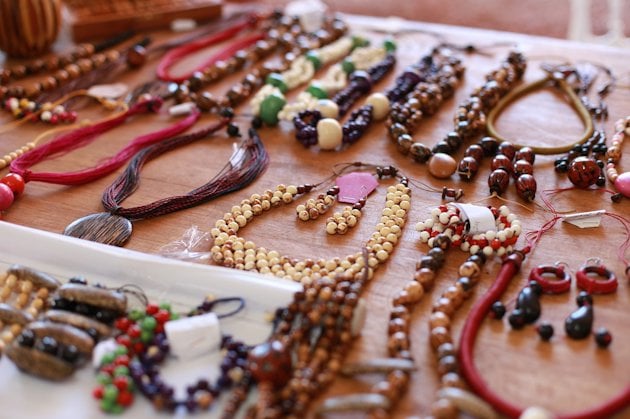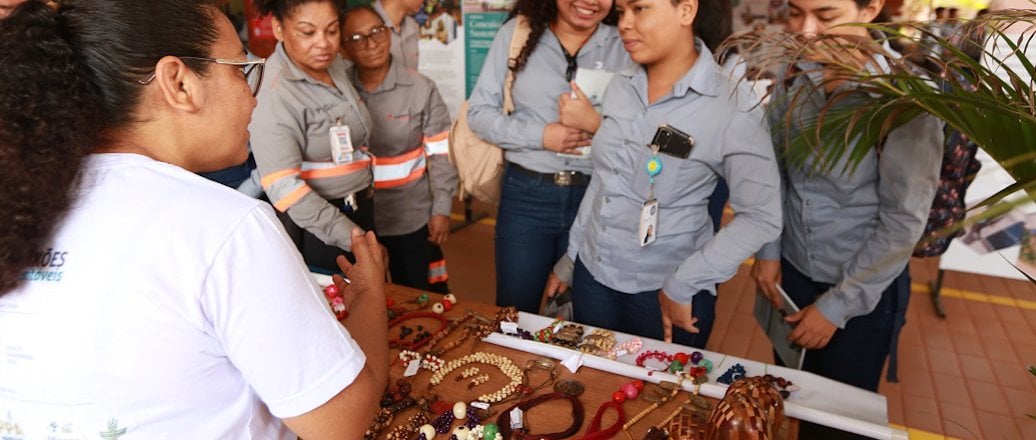Sustainable fashion is gaining more and more space, and the biojewelry market is expanding due to the beauty and originality of the pieces, such as accessories that enhance any look. In addition to being made from natural materials, in a basically artisanal process, the pieces value local culture by rescuing aspects of the history, beliefs, values, and traditions of the Amazonian people.
Engaged with the opportunity to promote local sustainability and encourage entrepreneurship, women from riverside areas of Cafezal, in Barcarena, Pará, are receiving training to become biojewelry artisans, supported by the Arte do Saber project, executed by Naturart (Agroextractivist Association PAE and Housing Nature and Art of the Municipality of Barcarena). The project is part of the Community Base II call from Sustainable Connections, with support from the Hydro Sustainability Fund (FSH, in portuguese).
With an initial duration of nine months, the project aims to assist women in generating their own income and thus improving their quality of life. Workshops on the production and assembly of the pieces are offered, as well as marketing workshops, using raw materials extracted from the territory itself. "In these workshops, they are learning to develop all communication materials, improve the quality of biojewelry production, and learn marketing techniques. The course also seeks to contribute to the self-confidence and self-esteem of each participant," emphasizes Milene Maués, partnership manager of FSH.
From thread to seed beads, everything is natural. The material is financed by FSH, and the course audience consists of women aged 18 and over who reside in the Cafezal neighborhood and surrounding areas, mainly on the islands. "We found a varied audience of around 50 participating women, from young to elderly. Since the course has not yet reached the pricing phase for the pieces, the production is not yet being sold commercially, but Naturart has participated in some exhibitions and placed some pieces for sale," highlights Milene.

At the end of the training, scheduled for August of this year, women will be able to obtain an artisan ID card, which will facilitate their entry into the job market, in partnership with the Secretariat of Social Assistance, Labor, Employment, and Income (SEASTER), of the State Government.
Transformative therapy
The production of biojewelry is not just work for many of these women; it is transformative therapy. For Helane Cristina Pastana dos Santos, 43 years old, a single mother, the project has contributed to her quality of life. "When I joined the project, I was going through a very difficult time, with no prospects of improving my life, and this occupation has been therapy for me. I already worked with biojewelry production, but in a very rudimentary way, without the knowledge I have now. And now, with better production, I intend to increase my income even more because I have always been self-employed, and I am very excited and grateful. I'm glad I found myself in handicrafts," says Helane.
For Maria Lina Costa Moraes, 64, also a single mother and retired kindergarten teacher, making biojewelry was already a long-standing passion. In addition to retirement, she says that the income from selling biojewelry already contributes significantly to the family's livelihood. "With the project, I want to improve my biojewelry, with new shapes and higher quality. The project has welcomed us as a family, and it is always a joy to be here. It has helped to save many women from depression. Also, I believe that being an artisan is telling a little bit of our history through the pieces we make," says Lina.
Sustainable fashion
Made with forest products, biojewelry are sustainable fashion accessories handmade with materials such as acai seeds, paxiúba, caranã, jarina, mititi, and jupati, pendants made from chestnut hedgehog and reused wooden beads. Pieces of this type produced in the Amazon region help to stimulate the economy in Pará and enchant with their beauty and representativeness. Behind each unique handicraft piece is the unique story of an artisan and the collective history of a community. "When someone buys a jewel made with forest elements, they are also taking along the emotion of the existence of the producer and a piece of the cultural roots of the people," says Milene Maués.
Another important point is that biojewelry are biodegradable; their decomposition process in nature is faster. Bracelets, necklaces, earrings with regional traits are part of the production.
About Sustainable Connections
The Sustainable Connections Platform finances socio-environmental projects on themes prioritized by the Barcarena Sustainable Initiative and seeks to promote positive transformations for the development of Barcarena, benefiting primarily local community organizations that have difficulties accessing credit. The values of the calls total 3.6 million reais.
: April 22, 2024







